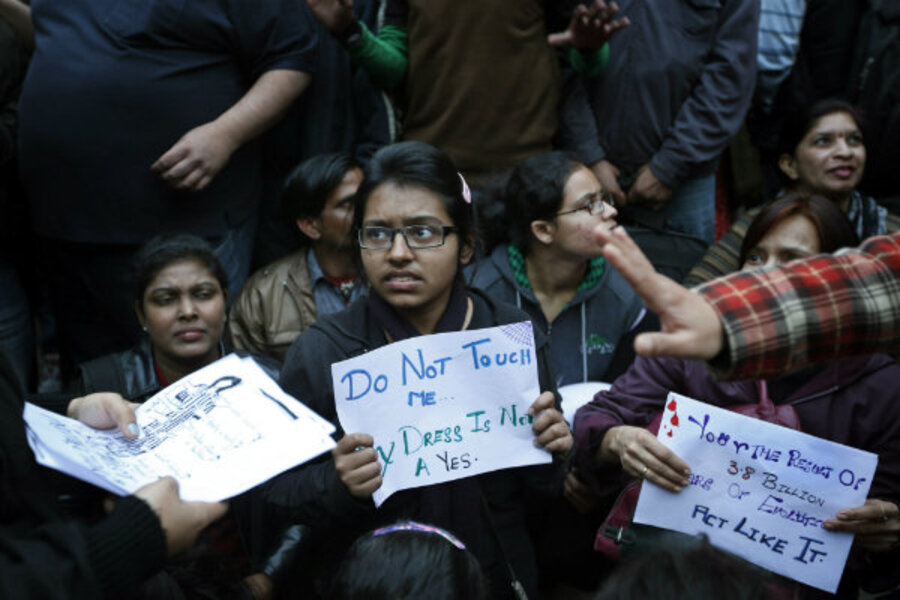India gang rape: How to reduce violence against women
| Bangalore, India
The recent death of a 23-year-old woman who was gang-raped on a commuter bus in New Delhi has momentarily called the world’s attention to an all-too-common occurrence in India. Perhaps there is an opportunity for others to benefit from this young woman’s tragic death.
For the past 15 years, I have been researching the links between gender inequalities and women’s health in India. During the course of this work, my team and I have documented hundreds of women’s stories – stories of family violence, of quiet resistance and resilience, of romantic dreams transformed into the mundane realities of housework and the numbing pain of marital abuse and rape.
In a national representative sample survey in 2005-2006, 2 in 5 married women between 15 and 49 years old reported experiencing physical, sexual, or psychological abuse by their husband at some point in their married lives. More than half of the young married women (16- to 25-year-olds) whom we recruited from slums in Bangalore to participate in our study reported having ever been hit, kicked, or beaten by their husband. Nearly 80 percent reported physical, sexual, or psychological abuse perpetrated by their husband or another member of the family. The scale of violence against women by those most intimately related to them is staggering.
The physical and mental health impacts of violence against girls and women across India are myriad and include under-nutrition, unwanted pregnancy, miscarriage, gynecological problems, sexually transmitted infections, social isolation, poor self-esteem, low perceived quality of life, depression, and suicidal tendencies.
In our study in Bangalore, 2 in 5 young women who reported experiencing violence had contemplated or attempted suicide. Moreover, the adverse impacts extend across generations. Infants born to mothers who experience violence are more likely to be born pre-term, have low birth weight, and to die within the first 28 days of life. Witnessing family violence in childhood increases the likelihood that a girl will experience violence as an adult and that a boy will grow up to perpetrate violence against his intimate partner – perpetuating the cycle of violence and ill health.
Yet women are not silent victims. Although a large number of women do accept violence as part of their lot in life or put up with it for the sake of their children or because they perceive no alternative, many seek support. All too often, they are rebuffed and silenced by the government, communities, and even their families – as India and the world have seen repeatedly in recent days.
Violence against girls and women is a fundamental violation of human rights. It is imperative that the Indian government, communities, and families respond. As noted extensively in the media, awareness and implementation of existing laws to protect girls’ and women’s rights (and there are several in India) must be ensured. Critical services – law enforcement, health, and allied supports – need to be readily accessible to women.
The public health sector has a key role to play. Primary health-care providers are uniquely positioned to raise community awareness about women’s rights and to offer abused women access to critical health and social support services. I am working with the municipal government of Bangalore to build a public primary health-care system response to violence against women.
Efforts to directly address women’s and men’s attitudes – through outreach to homes, schools, communities, and workplaces – are also needed. For centuries, Indian religious texts, social norms, and customs have perpetuated unequal relationships between men and women. These attitudes are changing – as illustrated by the surge of discontent and anger in response to violence against women across the country – but change is not happening widely enough.
In Bangalore, we are mobilizing older women in the family – mothers-in-law – to stand up against family violence. The nongovernmental organization, Bangalore Medical Services Trust, has launched a workplace gender equity promotion program that uses a participatory approach. They engage employees in designing and implementing a workplace campaign to promote gender-equitable attitudes and raise awareness regarding legal and social support services for abused women through print, popular folk art, and personal histories. Individuals in need are actively linked to support agencies.
This effort has led to dramatic shifts in male and female garment workers’ attitudes: At the outset of the program, 70 percent of women and men said that there were times when a woman deserves to be beaten, but by the end of the first year of implementation, the proportion condoning violence had declined to less than 20 percent.
Violence against women is not inevitable. As demonstrated by these emerging programs in Bangalore, systematic and sustained efforts can lead to positive social change in the relatively short term. The Indian government needs to invest in developing strategies to promote gender-equitable attitudes and safe spaces for girls and women. The government should also invest in generating evidence on what works, with whom it works, and how, so that investments can have maximum impact.
It is encouraging that in August, President Obama issued an executive order stating his administration’s commitment to prevent and respond to violence against women and girls worldwide. The tragic death of a young woman in India should serve as a catalyst for furthering US efforts to support program development for women and ongoing research about this epidemic of violence in India and elsewhere in the world. Now is the time for action.
Suneeta Krishnan is a social epidemiologist with RTI International and also an adjunct professor of epidemiology at the St. John’s Research Institute, Bangalore.





